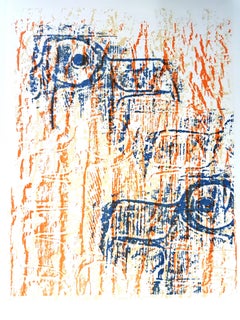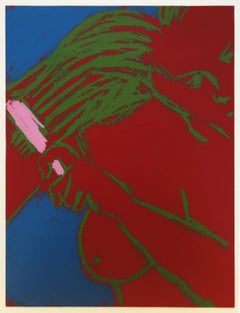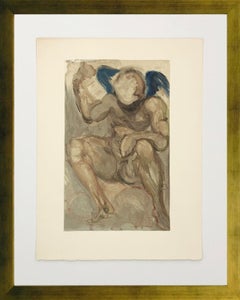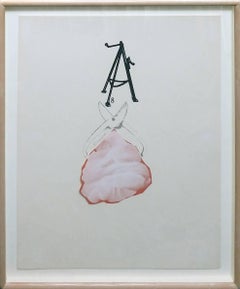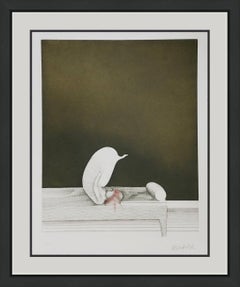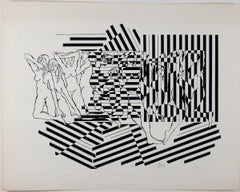Figurative Prints on Sale
to
1,096
367
131
35
13
Overall Width
to
Overall Height
to
601
591
126
50
44
17
17
7
2
2
336
161
35
32
27
413
871
6,948
1,071
30
110
436
273
732
1,326
1,642
1,124
464
322
376
1,304
334
1
1,080
710
481
414
350
279
278
206
61
41
40
39
37
33
31
29
28
28
27
26
1,110
255
88
87
87
66
162
1,468
82
Sale Items
Period: 1960s
Max Ernst - Birds - Original Lithograph
By Max Ernst
Located in Collonge Bellerive, Geneve, CH
Max Ernst - Birds - Original Lithograph
Birds, 1964 (BNF, 63)
Dimensions: 32 x 24 cm
Revue Art de France
ax Ernst was born in Bruhl, a place near Cologne, in Germany. He was raised in a strict Catholic family, and both of his parents were disciplinarians who were dedicated to training their children into God-fearing and talented individuals. Although his father was deaf, Ernst learned so much from him, particularly when it comes to painting. In fact, much of his early years were lived under the inspiration of his father who was also a teacher. He was the one who introduced painting to Ernst at an early age.
In 1914, Ernst attended the University of Bonn where he studied philosophy. However, he eventually dropped out of school because he was more interested in the arts. He claimed that his primary sources of interest included anything that had something to do with painting. Moreover, he became fascinated with psychology, among other subjects in school.
Primarily, Ernst's love for painting was the main reason why he became deeply interested with this craft and decided to pursue it later on in his life. During his early years, he became familiar with the works of some of the greatest artists of all time including Claude Monet, Paul Cezanne and Vincent van Gogh. He was also drawn to themes such as fantasy and dream imagery, which were among the common subjects of the works of Giorgio de Chirico.
During World War I, Ernst was forced to join the German Army, and he became a part of the artillery division that exposed him greatly to the drama of warfare. A soldier in the War, Ernst emerged deeply traumatized and highly critical of western culture. These charged sentiments directly fed into his vision of the modern world as irrational, an idea that became the basis of his artwork. Ernst's artistic vision, along with his humor and verve come through strongly in his Dada and Surrealists works; Ernst was a pioneer of both movements.
It was Ernst's memories of the war and his childhood that helps him create absurd, yet interesting scenes in his artworks. Soon, he took his passion for the arts seriously when he returned to Germany after the war. With Jean Arp, a poet and artist, Ernst formed a group for artists in Cologne. He also developed a close relationship with fellow artists in Paris who propagated Avant-Garde artworks.
In 1919, Ernst started creating some of his first collages, where he made use of various materials including illustrated catalogs and some manuals that produced a somewhat futuristic image. His unique masterpieces allowed Ernst to create his very own world of dreams and fantasy, which eventually helped heal his personal issues and trauma. In addition to painting and creating collages, Ernst also edited some journals. He also made a few sculptures that were rather queer in appearance.
In 1920s, influenced by the writings of psychologist Sigmund Freud, the literary, intellectual, and artistic movement called Surrealism sought a revolution against the constraints of the rational mind; and by extension, they saw the rules of a society as oppressive. Surrealism also embraces a Marxist ideology that demands an orthodox approach to history as a product of the material interaction of collective interests, and many renown Surrealism artists later on became 20th century Counterculture symbols such as Marxist Che Guevara. In 1922 Ernst moved to Paris, where the surrealists were gathering around Andre Breton. In 1923 Ernst finished Men Shall Know Nothing of This, known as the first Surrealist painting. Ernst was one of the first artists who apply The Interpretation of Dreams by Freud to investigate his deep psyche in order to explore the source of his own creativity. While turning inwards unto himself, Ernst was also tapping into the universal unconscious with its common dream imagery.
Despite his strange styles, Ernst gained quite a reputation that earned him some followers throughout his life. He even helped shape the trend of American art during the mid-century, thanks to his brilliant and extraordinary ideas that were unlike those of other artists during his time. Ernst also became friends with Peggy Guggenheim, which inspired him to develop close ties with the abstract expressionists.
When Ernst lived in Sedona, he became deeply fascinated with the Southwest Native American navajo art. In fact, the technique used in this artwork inspired him and paved the way for him to create paintings that depicted this style. Thus, Ernst became a main figure of this art technique, including the rituals and spiritual traditions included in this form of art. Pollock, aside from the other younger generations of abstract expressionists, was also inspired by sand painting of the Southwest...
Category
1960s Surrealist Animal Prints
Materials
Lithograph
WOMAN BRUSHING HER HAIR
By George Segal
Located in Aventura, FL
Original screenprint on paper. From the New York Ten portfolio. In the collection of MOMA. Hand signed and numbered by the artist. Edition of 200. Framed.
Additional images availa...
Category
1960s Pop Art Portrait Prints
Materials
Paper, Screen
PURGATORY CANTO 15
By Salvador Dalí
Located in Aventura, FL
Woodblock engraving on paper from the Divine Comedy series. Sheet size 13 x 10 inches. Frame size approx 18 x 15 inches. Edition 4,765 in French, 3,000 in Italian, 300 in German.
...
Category
1960s Surrealist Figurative Prints
Materials
Paper, Woodcut
TOOL BOX 2
By Jim Dine
Located in Aventura, FL
Hand signed on front; numbered on verso by the artist. From the 'A Tool Box' Portfolio. Printed by Christopher Prater; published by Editions Alecto. Artwork is in excellent condition...
Category
1960s Pop Art Interior Prints
Materials
Screen, Paper
SOFAFIGUR
By Paul Wunderlich
Located in Aventura, FL
Hand signed and numbered by the artist. Etching and aquatint on lana paper. Image size 19.3 x 14.9 in. Frame size approx 29 x 25 in. Edition of 95. Certificate of authenticity includ...
Category
1960s Surrealist Portrait Prints
Materials
Etching, Paper, Aquatint
Contemporary Limited Edition Fine Art Screen Print - Twelve Nudes 360.056
Located in New York, NY
Linda Stein, Twelve Nudes 360.056 - Contemporary Limited Edition Fine Art Screen Print
Linda Stein has been practicing art for the last six decades. This limited edition screen pr...
Category
1960s Contemporary Figurative Prints
Materials
Screen
HELL CANTO 20
By Salvador Dalí
Located in Aventura, FL
Woodblock engraving on paper from the Divine Comedy series. Sheet size 13 x 10 inches. Frame size approx 18 x 15 inches. Edition 4,765 in French, 3,000 in Italian, 300 in German.
...
Category
1960s Surrealist Figurative Prints
Materials
Paper, Woodcut
HEAVEN CANTO 5
By Salvador Dalí
Located in Aventura, FL
Woodblock engraving on paper from the Divine Comedy series. Sheet size 13 x 10 inches. Frame size approx 18 x 15 inches. Edition 4,765 in French, 3,000 in Italian, 300 in German.
...
Category
1960s Surrealist Figurative Prints
Materials
Paper, Woodcut
Untitled (Fleur Tombe), 1962
By Georges Braque
Located in Palo Alto, CA
The rich blue color bursts from the page in Georges Braque Untitled (Fleur Tombe), 1962, overtaking the black lettering and white background. Drawn onto the title page of the book “Braque Le goût de notre temps” by Albert Skira this hand applied watercolor is striking. In several strong stokes, a flower is presented with its blue petals seeming to float down the page until almost reaching the bottom. The delicate blue touches the page which in turn lights up with brilliant flowers. The petals are slightly smudged, and you can see the brushstrokes that Braque applied to the page. PArt of what makes this unique watercolor so wonderful is that the viewer can so clearly see and feel the hand of the artist. Caught in between the flower and falling petals is the black hand...
Category
1960s Modern Figurative Prints
Materials
Watercolor
HELL CANTO 25
By Salvador Dalí
Located in Aventura, FL
Woodblock engraving on paper from the Divine Comedy series. Sheet size 13 x 10 inches. Frame size approx 18 x 15 inches. Edition 4,765 in French, 3,000 in Italian, 300 in German.
...
Category
1960s Surrealist Figurative Prints
Materials
Paper, Woodcut
ARROW WITH RED END
By Allan D'Arcangelo 1
Located in Aventura, FL
Hand signed, dated and numbered lithograph. Sheet size 20 x 24 inches. Custom framed as pictured. From the edition of 100. Artwork is in excellent condition. Certificate of Authen...
Category
1960s Abstract Abstract Prints
Materials
Paper, Lithograph
L'Etang from Lettera amorosa, 1963
By Georges Braque
Located in Palo Alto, CA
As black remnants of flora float on top of green patches of murky water, a sense of frenzied movement overtakes this small composition. Stark black lines crisscross as if done in cha...
Category
1960s Modern Figurative Prints
Materials
Lithograph
La Charrue (The Plough)
By Georges Braque
Located in Palo Alto, CA
Combining the organic with the technical, Braque (Argenteuil-sur-Seine, 1882- Paris, 1963) depicts a plough against a background of graphing squares. The plough appears as if in wate...
Category
1960s Modern Figurative Prints
Materials
Lithograph
Page 63 from Si je mourais la-bas, 1962
By Georges Braque
Located in Palo Alto, CA
Georges Braque Page 63 from Si je mourais la-bas, 1962, captures the heart of many with its poignant and inspiring shade of cobalt blue. Rendered on cris...
Category
1960s Modern Figurative Prints
Materials
Engraving
Page 47 from Si je mourais la-bas
By Georges Braque
Located in Palo Alto, CA
Created to accompany poetry in the book Si je mourais la-bas by Guillaume Apolliaire, this lovely woman detailed in a soft delicate profile we can only a...
Category
1960s Modern Figurative Prints
Materials
Engraving, Woodcut
Le Feuille morte from Lettera amorosa, 1963
By Georges Braque
Located in Palo Alto, CA
A leaf rests on the sheet in Georges Braque Le Feuille Morte from Lettera Amorosa, 1963 as a testament to the beauty found in the cycle of nature. As gorgeous pink and brown tones wi...
Category
1960s Modern Figurative Prints
Materials
Lithograph
Lithograph from Le tir à l'arc (The Archery)
By Georges Braque
Located in Palo Alto, CA
This abstract Georges Braque Le tir à l'arc (The Archery), 1960 toys with repetitive motifs that vary ever so slightly. Four white, rectangular figures arranged in a square formation...
Category
1960s Modern Figurative Prints
Materials
Lithograph
Le Liseron vert from Lettera amorosa, 1963
By Georges Braque
Located in Palo Alto, CA
Famed printer Mourlot describes the years-long development of this collaboration between the poet René Char and the artist; the project grew from an "Understanding between Georges Br...
Category
1960s Modern Figurative Prints
Materials
Lithograph
